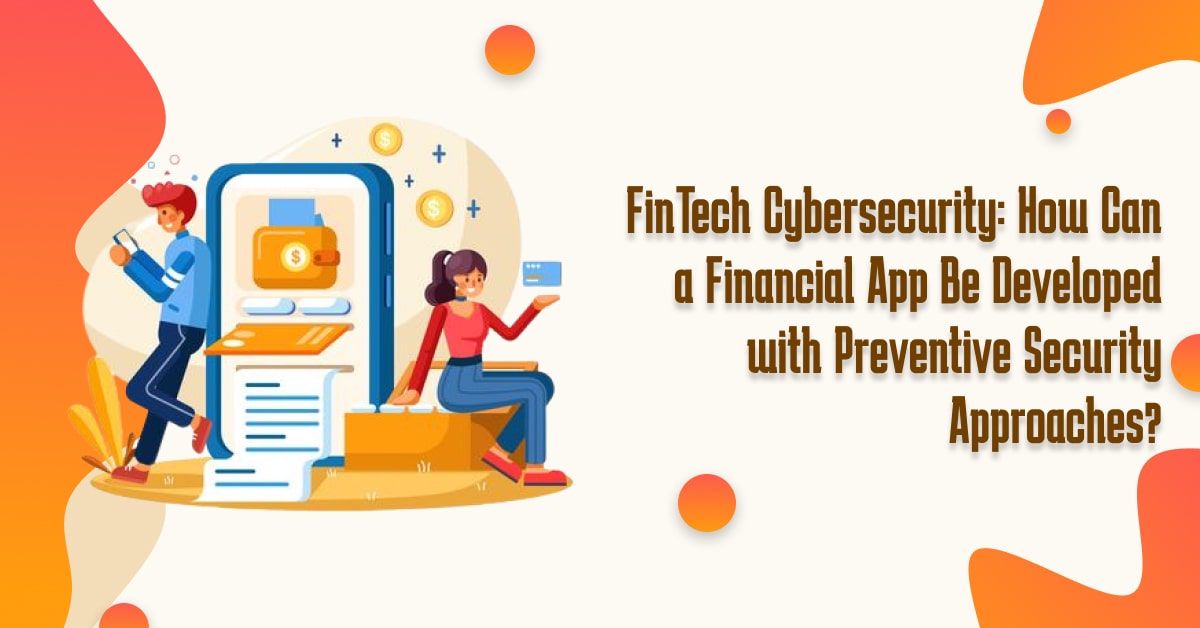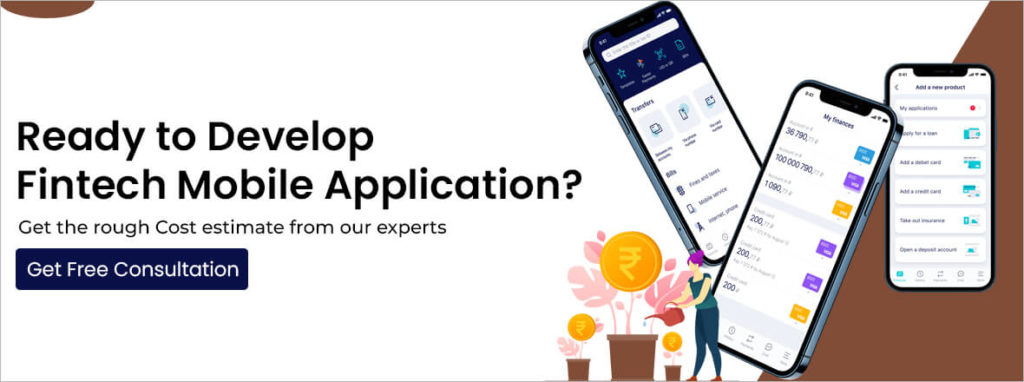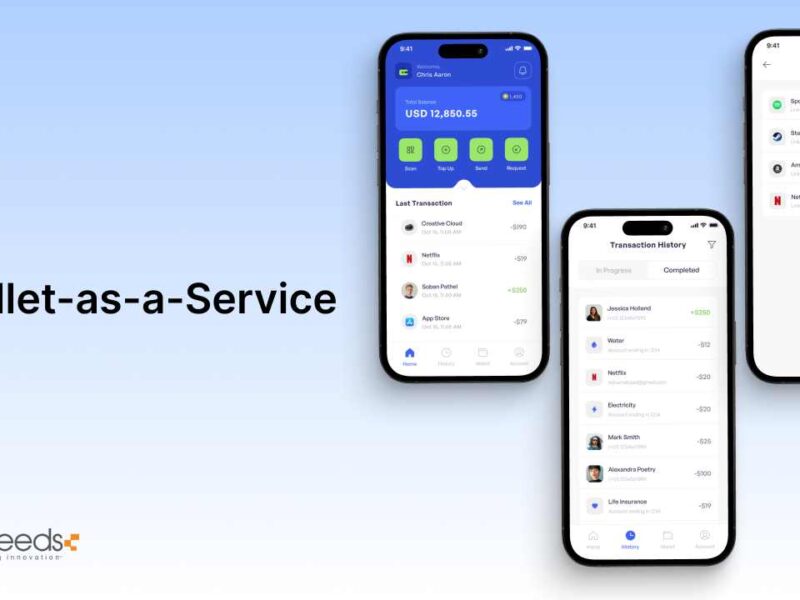In the rapid world of financial tech, the development of secure financial applications is of paramount importance. The need for vigorous cyber-security in fintech cannot be overstated as the sector continues revolutionizing how we deal with money. This blog will discuss different aspects of building a financial app, emphasizing preventive security approaches.
Financial apps deal with preventive data such as personal and financial data, making them attractive targets for cyber-criminals. To mitigate such risks, developers should adopt proactive strategies that may prioritize security from the very start.
From complying with industry regulations to executing data encryption and robust authentication methods, different preventive measures can fortify your financial application against threats.
In this blog, we will delve into the key steps and best practices to develop a financial app that provides innovative financial services and ensures the trust and safety of your users.
Importance of Cyber-security in Fintech
Cybersecurity for fintech is essential for business as it safeguards customer data, ensures secure transactions, prevents and detects fraud, and helps maintain regulatory compliance.
As the financial tech landscape continues to evolve and grow, robust cyber-security measures are significant for protecting businesses and their customers from cyber threats.
Let’s explore the importance of cyber-security in fintech.
Securing Transactions
FinTech platforms provide different financial transactions, such as payments and investments. Ensuring such transactions’ security is significant for preventing unauthorized access or fraudulent practices.
Customers’ Data Should Be Safeguarded
FinTech cybersecurity companies often deal with sensitive customer data like confidential identification details, payment card data, and financial records. Protecting this data is paramount for maintaining trust and avoiding possible legal consequences in case of data breaches.
Regular Security Audits Must Be Conducted
Continuous security audits and vulnerability evaluations are significant for addressing and rectifying the possible weaknesses in the FinTech system. This proactive approach supports avoiding security breaches.
Detecting Fraud
Cybersecurity in fintech measures to address and mitigate fraudulent practices such as theft, unauthorized transactions, and account takeovers. Early detection can reduce financial losses and also protect consumers.
Implementing Blockchain Technology
Blockchain tech alias for its robust security features can be combined into FinTech systems to improve data integrity and protect against tampering or unauthorized access.
Employee Training
Employees play a critical role in maintaining cyber-security. Adequate training ensures that employees know the security best practices like eliminating phishing attacks, considering strong passwords and identifying suspicious patterns.
Cooperation With Security Experts
Collaborating with cyber-security experts or companies specializing in FinTech security can offer valuable insights, threat intelligence, and solutions for identifying emerging threats significantly.
Utilizing Biometric Authentication
Biometric authentication methods, like facial recognition or fingerprint, add an extra layer of security, making it harder for unauthorized people to increase access to accounts or sensitive information.
Keeping One Step Ahead Of Cyber Threats
Cyber threats are continuously evolving. Staying up-to-date and proactive with the current cyber-security trends and threats is significant for significantly anticipating and defending against possible attacks.
Compliance With Regulatory Standards
The financial industry is highly regulated, and non-compliance can result in heavy penalties. FinTech businesses should adhere to industry-specific standards and regulations to protect financial security and data.
How to Build A Secure FinTech App?
Developing a secure FinTech app needs a holistic strategy focusing on security at each step of development and operation. You can create a trustworthy and fast financial tech app by illustrating the outlining features of the app’s purpose, designing an intuitive user interface, following secure development practices, and constantly assessing and monitoring for security threats.
It meets the requirements of both your customers and business. Let’s break down each step in detail:
Define Your App’s Purpose
Before diving into the development, it is significant to define the goal and objectives of your FinTech app. Comprehend the financial services you intend to offer, whether payment processing, lending, investment management, or something else.
Moreover, address your target audience and their unique requirements. Illustrating your app’s purpose will guide all subsequent decisions, such as security measures because different financial services have distinct security needs.
Outline the Features and Functionalities
Once you have a precise aim, outline the functionalities and features of your FinTech app. You must include the user journey, such as account management, authentication, registration, and transaction processing.
Security must be integrated at each step of the user experience. For instance, execute multi-factor authentication (MFA) for user logins and encryption for data storage and transmission. Clearly define data access controls, audit trails, and user permission to ensure data security and integrity.
Design Intuitive User Interface
An intuitive and user-friendly is significant for FinTech apps, but it must not compromise security. During the design stage, emphasizing developing a user experience that balances ease of use with safety.
Execute features such as secure password policies, biometric authentication, and clear notifications about financial transactions. It ensures that users can easily access and comprehend their account activity and transaction history, which is significant for fraud detection.
Develop, Test and Deploy the App to the Market
During the development step, select secure coding practices and frameworks. Regularly update third-party libraries and elements for patching known vulnerabilities. You must conduct thorough security testing, including code reviews and penetration testing.
It helps to fix and identify vulnerabilities. Use secure development activities such as output encoding, parameterized queries, and input validation to prevent common security flaws like Cross-Site Scripting (XSS) and SQL injection.
Once the application is thoroughly secure and tested, deploy it to the market.
Analyze, Monitor, and Iterate
After the application is live, your work is not over. Continuous monitoring, analysis, and iteration are significant to maintain security. Execute real-time monitoring for suspicious practices and irregularities in user behaviour.
You must regularly review logs and audit trails to address possible security breaches. Stay up-to-date about security patches and updates for the underlying techs of the app. You must be prepared to respond rapidly to security incidents and have an incident response plan.
Iterate the security features and practices of the app according to evolving threats and user feedback.
Fintech Cyber-security App Development Cost
Fintech cyber-security app development costs from $50,000 to $300,000 or more. It commonly relies on factors like the chosen platform, feature complexity, app type, development company’s location, security measures, testing, ongoing maintenance, and regulatory compliance. Knowledge of project needs, cautious planning, and a realistic budget are significant for effective fintech app development.
Let’s evaluate each of such factors in depth:
Type of App
The type of fintech application you are developing matters. Are you creating a mobile banking app, a peer-to-peer lending platform, a personal finance management tool or a stock trading app? The app’s functionality and complexity will vary depending on its type, affecting the development costs consequently.
Platform(s) of the App
The selection of platform(s) effectively impacts the development costs. Fintech apps could be developed for platforms like iOS, web, Android, and sometimes cross-platform solutions. Different platforms can increase costs because separate codebases and design considerations are needed.
Level of Security It Provides
When it comes to financial apps, protection is critical. The cost of growth goes up as the security measures get more robust and complete. End-to-end encryption, multi-factor authentication, fingerprint authentication, and safe API connections are some features that can increase the total cost. Still, they are necessary to protect private financial data.
App’s Features and Complexity
The complexity and number of features directly affect the development costs. A basic fintech app with limited functionality will cost less than a feature-rich application with advanced competencies. Features such as data analytics, real-time transaction tracking, secure communication channels, and investment tools can increase the development cost and complexity.
Regulatory Compliance
Fintech apps often have to follow strict rules about money and data security. Ensuring compliance can take more development work and ongoing upkeep, adding to the total cost.
Location of the Fintech App Development Company
The location of the fintech app development company can significantly affect costs. Most of the time, development firms in places with high living costs, like North America and Western Europe, charge more per hour than firms in Eastern Europe, Asia, or South America. But it’s essential to find a mix between cost and the quality and skill of the production team.
Maintenance and Updates
Once a financial app is released, it needs regular support, maintenance, and updates to fix bugs, add new features, and apply security changes. Consider how much it will cost to keep the app working and safe in the long run.
Testing and Security Audits
Fintech apps must undergo thorough testing and security audits to find and fix flaws. These testing stages take longer and cost more, but they are necessary to ensure the app is safe.
Best Practices to Ensure Cyber-security in Your Fintech Business
By following best practices, a fintech app development company can strengthen its safety, lower the risk of data breaches, and gain customers’ trust. There is always work on cyber-security for fintech, and keeping up with new dangers and tools to avoid problems is essential. To do this, here are the best ways to do it:
Secure Data Storage
It is essential to protect data while it is at rest. To keep private data safe in your systems, use robust encryption methods. At both the program and database levels, you should use encryption. Ensure that the security keys are kept safely and that only authorized people can view the data. Review and examine your data-keeping methods regularly to find and fix any security holes.
Comply with Industry Standards and Regulations
A crucial part of FinTech protection is ensuring industry-specific rules and standards are followed. Learn about the laws that apply to you, such as GDPR, PCI DSS, or local financial regulations. Following these rules ensures you meet the basic security requirements and lowers the chance of getting in trouble with the law. Regularly update your policies and processes to stay in line with changing rules.
Write Secure App Code
One of the most critical steps in FinTech protection is writing secure code. Teach your development team safe ways to code to stop standard security holes like SQL injection, Cross-Site Scripting (XSS), and unsafe deserialization. To find and fix security holes early in the development process, do thorough code reviews and automatic security tests. To protect against web-based threats, you should also use security messages and data checking.
Regularly Update and Patch Systems
To protect against known flaws, keeping software, operating systems, and libraries up to date is essential. All your hardware, like the server, database, and third-party tools, should have security fixes and updates applied regularly. Use automatic tools to look for security holes and fix them quickly.
Implement Secure APIs, Data Encryption, and Two-Factor Authentication
Secure APIs are very important in FinTech because they let different systems talk to each other safely. Set up solid ways for users to log in and be authorized to access APIs. Use OAuth 2.0 or JWT (JSON Web Tokens) to protect API endpoints.
Use industry-standard methods like TLS for communication and robust encryption algorithms for storing to protect data both while it is being sent and while it is being held. Two-factor authentication (2FA) adds an extra layer of security to user access, ensuring that a second authentication is still needed even if passwords are stolen.
Educate and Train Employees
Your employees are often the first people who stop online threats. Spend money on cyber-security training for your workers to teach them about best practices for security, like how to spot phishing attempts and keep private data safe. Promote a mindset of security awareness in your fintech app development company.
Conduct Regular Security Audits and Penetration Testing
Do security audits and penetration tests regularly to check the security of your FinTech system. These things can help you find holes and weak spots in your programme and strategy. Hire outside security experts to do these tests for a fair look at your security steps.
Real-World Examples of Top-Notch Fintech Applications
Different fintech apps have gained recognition for their innovative solutions, user-friendly interfaces, and emphasis on security. They showcase how technology changes the financial industry, making financial services highly accessible and efficient for businesses and individuals.
Let’s check out some real-world examples of top-notch fintech cybersecurity companies.
PayPal
It is one of the leading online payments and digital wallets. It enables users to make online payments, transfer money to friends and family, and conduct e-commerce transactions securely. PayPal provides features like buyer and seller protection, two-factor authentication, and integration with different online merchants, making it a highly used and trusted Fintech app at the global level.
Robinhood
It is a commission-free stock and cryptocurrency trading application. It disrupted the conventional brokerage industry by letting users buy and sell stocks, ETFs, cryptocurrencies, and options without paying traditional trading fees. It provides user-friendly interfaces, real-time market data, and educational resources to empower individuals to invest in financial markets.
Mint
It is a personal finance management app that enables users to manage their finances, track expenses, create budgets, and set financial goals. It automatically classifies transactions, offers insights into spending patterns and provides suggestions to save money. Mint provides cashback rewards on particular purchases.
Square Cash (Cash App):
Cash app is developed by Square that lets users send and receive money, invest in Bitcoins and stocks, and even get a cash card to spend. It is known for its simplicity and ability to split bills with friends easily. The cash app provides optional features like Boost and offers cashback rewards on specific purchases.
Stripe
It is a payment processing platform that enables companies to accept online payments. It provides a developer-friendly API, facilitates a broader category of payment methods, and provides robust security features for protecting against fraud and data breaches. Different eCommerce businesses and startups use Stripe for its ease of integration and security.
Consider eBizneeds as Your Trusted Tech Partner for Fintech App Development
eBizneeds is a cyber-security fintech company with a good record of offering innovative solutions in the Fintech industry. eBizneeds has broader experience in the fintech domain. They comprehend the unique challenges and regulatory needs of financial sectors.
This expertise enables them to offer customized solutions that meet industry-specific standards and compliance requirements. Security is paramount in the fintech industry. eBizneeds has a strong focus on security best practices. They can aid you in developing secure web applications that protect sensitive financial data and ensure compliance with relevant standards.
eBizneeds keeps up with the latest tech trends and integrates advanced technologies like ML and blockchain into an app. It aids in improving its competitiveness and functionality.
Conclusion
In the dynamic field of fintech, where innovation aids in meeting financial services, cyber-security in fintech acts as the base of reliability and trust. Building a financial app with preventive security approaches is not only a choice. It is a significant aspect.
It adheres to industry regulations, safeguarding the data storage, writing secure code and executing advanced security features such as encryption and two-factor authentication, which are all integral steps in developing a resilient financial app.
By prioritizing cyber-security from the beginning of your fintech app development, you protect the user’s sensitive financial data and fortify the brand’s reputation.
In an environment where cyber-security is continually evolving, a proactive approach to security is critical for unlocking the full potential of financial apps while ensuring their reliability, integrity, and the peace of mind of your users.



Naveen Khanna is the CEO of eBizneeds, a company renowned for its bespoke web and mobile app development. By delivering high-end modern solutions all over the globe, Naveen takes pleasure in sharing his rich experiences and views on emerging technological trends. He has worked in many domains, from education, entertainment, banking, manufacturing, healthcare, and real estate, sharing rich experience in delivering innovative solutions.






